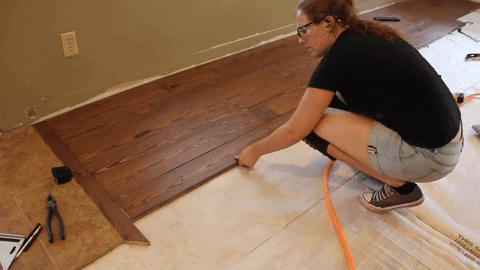
Installing hardwood flooring is a significant investment that can dramatically enhance the beauty and value of your home. However, even seemingly minor mistakes during installation can lead to costly repairs, premature wear, and a less-than-perfect finish.
This ultra-detailed guide will serve as your comprehensive roadmap, highlighting common pitfalls and providing expert strategies to ensure a flawless and enduring hardwood floor installation.
I. The Foundation of Failure: Subfloor Neglect and Moisture Mishaps
- 1. Ignoring Subfloor Irregularities:
- The Pitfall: Installing hardwood over an uneven, unstable, or damaged subfloor.
- The Consequences: Uneven floors, squeaking, buckling, and premature wear.
- The Solution:
- Thoroughly inspect the subfloor for any imperfections.
- Level uneven areas using self-leveling compound or plywood underlayment.
- Secure any loose boards or repair damaged areas.
- Ensure the subfloor is clean and free of debris.
- 2. Moisture Negligence:
- The Pitfall: Installing hardwood over a damp subfloor or without proper moisture barriers.
- The Consequences: Warping, cupping, mold growth, and adhesive failure.
- The Solution:
- Conduct thorough moisture tests on the subfloor.
- Install a high-quality moisture barrier, especially over concrete subfloor.
- Ensure proper ventilation during and after installation.
- Allow proper acclimation of the hardwood to the room’s humidity levels.
- 3. Acclimation Oversights:
- The Pitfall: Installing hardwood without allowing sufficient acclimation to the room’s temperature and humidity.
- The Consequences: Excessive expansion or contraction, leading to gaps, buckling, and warping.
- The Solution:
- Acclimate the hardwood flooring in the installation room for at least 48-72 hours.
- Maintain consistent temperature and humidity levels during acclimation.
- Use a moisture meter to check the moisture level of the wood.
II. Installation Inaccuracies: Precision and Planning are Paramount
- 4. Improper Layout Planning:
- The Pitfall: Starting with an incorrect layout or failing to account for room dimensions and obstacles.
- The Consequences: Uneven plank distribution, narrow planks at the end of rows, and a visually unappealing finish.
- The Solution:
- Carefully plan the layout, considering the room’s shape, natural light, and traffic flow.
- Use a chalk line to establish straight starting lines.
- Measure accurately and plan for transitions between rooms.
- 5. Incorrect Nailing/Gluing Techniques:
- The Pitfall: Improper nailing angles, spacing, or adhesive application.
- The Consequences: Loose planks, squeaking, and adhesive failure.
- The Solution:
- Use the correct flooring nailer and nails or cleats.
- Maintain consistent nailing angles and spacing.
- Apply adhesive evenly using the recommended trowel and pattern.
- Always follow the manufacturers instructions.
- 6. Inadequate Expansion Gaps:
- The Pitfall: Failing to leave sufficient expansion gaps around the perimeter of the room and around obstacles.
- The Consequences: Buckling, warping, and damage to the flooring.
- The Solution:
- Use spacers to maintain consistent expansion gaps.
- Follow the manufacturer’s recommendations for expansion gap width.
- Cover expansion gaps with baseboards or moldings.
- 7. Cutting Errors:
- The Pitfall: Inaccurate cuts, leading to gaps, uneven edges, and wasted material.
- The Consequences: A less-than-professional finish and increased material costs.
- The Solution:
- Measure and mark planks accurately before cutting.
- Use the appropriate saw and cutting techniques.
- Practice cutting on scrap pieces of hardwood.
- When cutting around obstacles, create templates.
- 8. Ignoring Directional Changes:
- The Pitfall: Failing to properly plan and execute directional changes in plank layout.
- The Consequences: An awkward and visually jarring transition between rooms.
- The Solution:
- Plan directional changes carefully, considering the flow of traffic and visual appeal.
- Use transition pieces or create seamless transitions using consistent plank direction.
III. Finishing and Post-Installation Pitfalls: The Final Touches Matter
- 9. Improper Finishing Techniques:
- The Pitfall: Applying the wrong finish or using incorrect finishing techniques.
- The Consequences: Uneven finish, poor durability, and discoloration.
- The Solution:
- Select a finish that is compatible with your hardwood species and desired aesthetic.
- Follow the manufacturer’s instructions for finish application.
- Apply multiple thin coats for optimal results.
- 10. Neglecting Post-Installation Care:
- The Pitfall: Failing to properly clean and maintain the hardwood flooring after installation.
- The Consequences: Scratches, dents, and premature wear.
- The Solution:
- Clean the flooring with a soft cloth and a wood floor cleaner.
- Use furniture pads to protect the flooring from scratches.
- Maintain consistent humidity levels to prevent warping.
- Avoid harsh chemicals.
IV. Tool and Material Mishaps: The Right Tools for the Right Job
- 11. Using Inadequate Tools:
- The Pitfall: Attempting installation with incorrect or low-quality tools.
- The Consequences: Damaged flooring, increased installation time, and a poor finish.
- The Solution:
- Invest in high-quality tools designed for hardwood flooring installation.
- Rent specialized tools if necessary.
- Ensure tools are clean and in good working order.
- 12. Incorrect Material Selection:
- The Pitfall: Choosing the incorrect underlayment, adhesive, or flooring nails.
- The Consequences: Flooring failure, and increased costs.
- The Solution:
- Always follow the flooring manufactures recommendations.
- Use the correct materials for the application.
V. Professional Oversight: When to Seek Expert Help
- 13. DIY Overconfidence:
- The Pitfall: Attempting complex installations without sufficient experience or knowledge.
- The Consequences: Costly mistakes, damaged flooring, and frustration.
- The Solution:
- Assess your DIY skills and experience honestly.
- Seek professional assistance for complex installations or if you are unsure about any aspect of the process.
By diligently avoiding these common hardwood installation mistakes, you can safeguard your investment and create a stunning and enduring hardwood floor that will enhance the beauty and value of your home for years to come.
